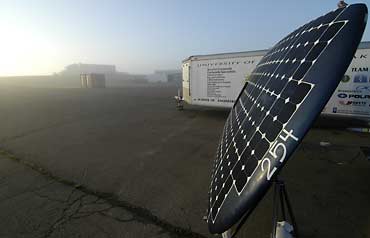Images splash on my mind's palette, crushed into a bizarre montage of our trip from Berkeley to Kansas:
Singing falsetto to Romanian techno. Camping near a Coliseum-sized Wal-Mart. Babysitting Tod, the Trailer of Death. Mingling with truckers. Twenty-four solar cars in a parking lot.
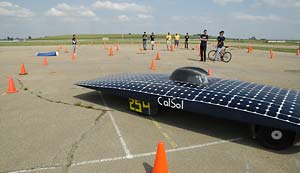 The Beam Machine navigates through figure 8's as part of the qualifying tests. |
The three-day road trip had a dreamlike feel, but checking in at the racetrack in Topeka to gaze at the competition, cruising in their polished cars, jolted me back to reality. WORK WORK WORK!
Our car was unfinished. Formula Sun Grand Prix, the combination track race and qualifier for the North American Solar Challenge, fell smack in the middle of final exams. Taking them early had detracted from working on the car. Then, a few days before leaving California, our electrical lead, Navtej, came down with mono. It was comforting to know I had shared a water bottle with him the weekend before, under the impression his sniffles were just "allergies". We pulled an all-nighter before leaving Berkeley, snored it off on the 29-hour drive, and plunked down Sunday afternoon to work more on the car. By the light, heat and grace of a halogen lamp, I soldered wires and diodes to the solar array until frigid 1 AM.
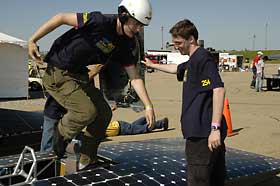 Jeremy practices egress maneuvers; drivers must be able to exit their cramped quarters in the car in under 10 seconds to pass this safety test. |
Monday and Tuesday were tense. We had seven tests to pound through before going on the track. We reserved slots with the inspectors, slaved on the car in between, and rescheduled most because we just weren't ready. We had to engineer quick solutions with limited resources after the scrutineers complained about certain parts on the Beam Machine. The intense pressure to pass, the fear of failure, and the baking heat frayed nerves. Official approval to race came just as the stations were closing on Tuesday. Hallelujah! That night, we shared laughs over our inexpensive but exotic sandwich dinner. Spencer won the Iron Chef award (Solar Car Team Edition) with his pastrami-cucumber-peanut butter-barbeque sauce-cheddar-apple triple-decker combo. It was either genius or insanity.
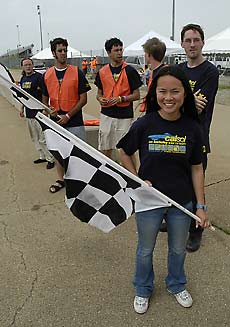 As Michelle holds the checkered flag in readiness, the CalSol pit crew (L to R: John, Greg, Kevin, Spencer, Paul) waits for the car to finish its 58th sub-5-minute lap to qualify for the North American Solar Challenge. |
Wednesday's 5:30 a.m. wake up call restarted the usual. Set up the Sam (Solar Array Maximizer) angled to the rising sun to charge the batteries. Race at nine. We had to complete 58 laps, each in under 5 minutes, to qualify. I grabbed a radio and headed for the official timer tent to time our car and pick up the chatter among other teams. Like why was the defending champion, University of Missouri-Rolla, without a solar array? Tsk, tsk. Yeah, our motor was annoyingly built too! Hey, what went wrong with so-and-so's car?
We planned to start off slowly with 4:45 laps, to conserve the charge in our battery pack. When Jonny, our primary driver, completed a lap in under 4 minutes, I radioed him to slow down. His response, heard by all the teams in the tent: "Sorry, I just wanted to pass Stanford."
By the end of Thursday, we had 156 laps, posted at fourth overall, third in stock class. (Stock class is limited by money, allowing teams with less funding to be competitive, while open class teams are free to spend any amount.) Amazingly, all four stock teams placed in the top five overall, with the University of Minnesota taking first as the only open class car. Wednesday night our neighbors, the Sol of Auburn team, kindly invited us to take showers at their motel. After the odor reduction, we tossed Frisbees and footballs around and kvetched about the BCS over some savory Mexican food. Their easygoing attitude, sense of fun, and generous hospitality were so endearing, we even drawled some "y'all's" into our speech.
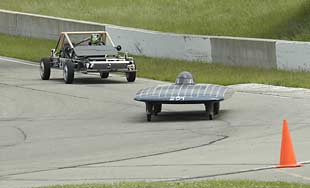 The University of North Dakota's hulking hydrogen-fueled car, the Hummer of alternative-power vehicles, trails the Beam Machine around the track. Below: In the braking test, the pavement was watered down to make it more challenging to stop in the required 1 second per 10 mph of speed. 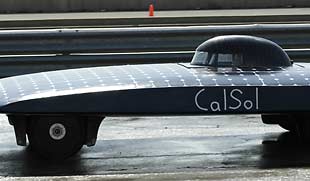 |
The Beam Machine waited until Friday to heat up a fiasco. As John Connors drove past the timer tent, he suddenly pulled over. Radio talk flared. "What's wrong?!" "Something's burning. I smell lithium." Lithium ion batteries are notoriously volatile, their fires impossible to extinguish. All cars were red-flagged to stop. Officials screamed "Get your battery protection, sand and a shovel!" Other teams sprinted to the site with fire extinguishers. I hopped the fence, only to be confronted with "EVERYONE STAND BACK." We agonized watching from a distance as Mike, our battery protection engineer, checked temperatures and voltages, clothed in welding gloves, sweatshirt and jeans.
We needed a superb run to beat Auburn for second. Around noon, a wheel came off Auburn's car, cracking a kingpin. They chose to stop racing. We had a chance, if we could fix the car. Hours after the red flag, we tracked the burning smell to a fried resistor. After some convincing, the officials let us back on the track. Jeremy took the wheel. Some laps later, he stopped in the middle of the road and exited the car amid smoke and another red flag. Some wires had rubbed up against the chassis tubing and started to scorch. Still in third place, with the fourth and second place teams already packing up, we decided to join them. We received our award, free pizza from the officials, and headed home to the Westside. "Raycing" had just begun.
Y'all keep in touch, ok?
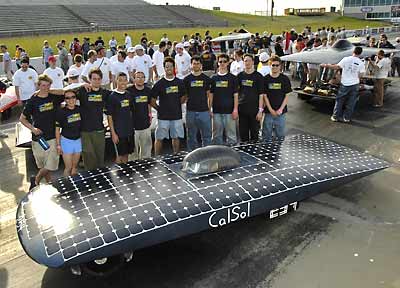 The CalSol team proudly poses with their qualifying car at the Heartland Park racetrack in Topeka. |





